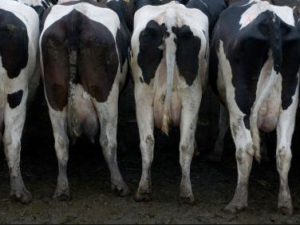The Minnesota Court of Appeals has ruled that a dairy farm cannot expand its operation, adding additional cows, without an “environmental impact statement” (EIS) analyzing its effect on global climate change. To be fair, there should be a similar legal requirement, whenever significant changes might affect agriculture, for a “dietary impact statement.”
Adding more cows might result in more methane gas emissions, as opponents say. But it might also result in a greater supply of milk and beef, and thus lower food prices. Perhaps educated consumers should be given all the information on both sides, and allowed to decide for themselves.
 John Hinderaker, the brilliant award-winning Minnesota attorney and author who runs the Center of the American Experiment, wrote a great piece for “PowerLine Blog” about dairy cows that are now “Tangled Up in the Green New Deal.” He suggests that the controversial environmental initiative signals a desire on the part of some extremists “to control every aspect of our lives,” because “everything we do, beginning with breathing, involves emission of carbon dioxide…”
John Hinderaker, the brilliant award-winning Minnesota attorney and author who runs the Center of the American Experiment, wrote a great piece for “PowerLine Blog” about dairy cows that are now “Tangled Up in the Green New Deal.” He suggests that the controversial environmental initiative signals a desire on the part of some extremists “to control every aspect of our lives,” because “everything we do, beginning with breathing, involves emission of carbon dioxide…”
For decades, activists have said cows producing methane, perhaps the worst “greenhouse gas,” are destroying the planet. Still, their leading voices – the UN climate change panel and Al Gore – have always stopped short of proposing to ban cows. But they have been displaced in the national debate, and now, New York City Rep. Alexandria Ocasio-Cortez’s “Green New Deal” does suggest banning cows. She has become more or less a laughing stock in most of the country because of such outlandish proposals, and Hinderaker writes that “No one, some would assume, could possibly take the Green New Deal’s war on cows seriously. In fact, it is deadly serious.”
The Minnesota court ruling proves his point. Daley Farms is a dairy operation run by the same family for six generations. In 1998 the county adopted a zoning rule limiting such businesses to no more 1,000 cows. The Daleys already had more than twice that number, so their farm was “grandfathered in” and continued operating. But the long-term result of that zoning rule contributed to a sharp reduction of dairy farms in that county, which lost over half the industry within a decade, including most of its smaller farms. Meanwhile, the dairy industry nationally has shifted toward much larger operations, and even in that county the total number of cows has increased over 30 percent – mostly on about ten large corporate farms. Thus, the Daleys asked to expand their operation, so it could remain competitive and continue to support the next generation.
Predictably, there was local opposition, including an angry public hearing and several letters to the editor complaining about the smell of cows, nasty impacts on groundwater, and all the other usual arguments against dairy farms – inevitably made be people who moved in after the farm had already been there for decades. Legal fees no doubt cost the family a small fortune.
The appellate court ruling, however, wasn’t about any of those complaints. Instead, the court sided with the environmental industry’s claim that any attempt to add cows ought to require a full EIS. Not the normal kind of bureaucratic document analyzing impacts on regional air, water, and wildlife – but far beyond that, trying to determine the impact on global climate change from the “cumulative” growth of a worldwide agriculture industry. As if it were remotely close to possible for anyone to determine the impact of a single herd of cattle on the world’s climate.
Even while acknowledging that there is no scientific way to do that, the court nevertheless ruled that an EIS is required, because of the “potentially significant environmental effects” of climate change.
Hinderaker writes that “If this decision stands, every farmer in Minnesota who wants to add more cows… will have to pay lawyers to prepare an Environmental Impact Statement that calculates the effect of the additional farm animals on the Earth’s average temperature. I can save them some money: the impact is zero, to however many decimal points you want to work it out to.”
While trying to wrap your mind around that conundrum, here is an easy fact to determine. Since the average dairy cow produces about 7.5 gallons of milk a day, and the average American drinks about 18 gallons a year, the 2,000 cows that the Daley family wants to add would produce enough milk for over 300,000 people. Any government policy that limits such production should require a “dietary impact statement” showing the effect on food supplies, and food prices.
A version of this column appeared in the Grand Junction Daily Sentinel November 8, 2019.




Comments on this entry are closed.